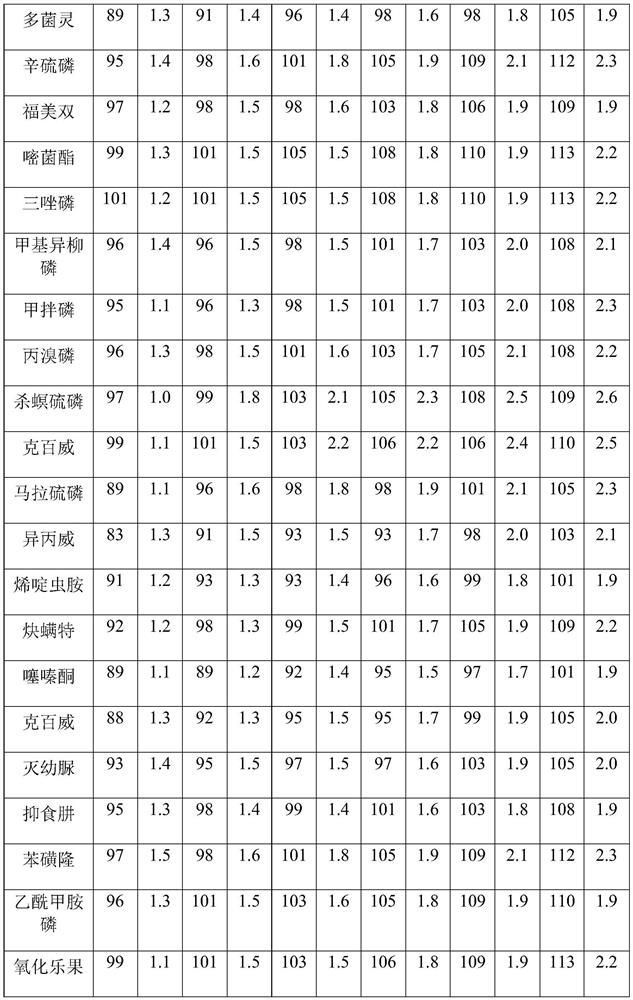Method for determining 47 pesticide residues in honey and bee pollen
A technology for pesticide residues and determination methods, which is applied in the direction of measuring devices, instruments, scientific instruments, etc., can solve problems that have not yet occurred, achieve high accuracy, solve matrix effect problems, and improve the recovery rate
- Summary
- Abstract
- Description
- Claims
- Application Information
AI Technical Summary
Problems solved by technology
Method used
Image
Examples
Embodiment 1
[0041] Embodiment 1: 47 kinds of pesticide residue assay methods in a kind of honey and bee pollen, comprise the following steps:
[0042] S1, extraction;
[0043] S1-1. Mix the honey sample and bee pollen sample with deionized water at a volume ratio of 1:3 to obtain the honey sample aqueous solution and the bee pollen sample aqueous solution; then mix the honey sample aqueous solution and the bee pollen sample aqueous solution with acetonitrile according to the volume ratio Mix 1:2 evenly to obtain mixed solution A and mixed solution B;
[0044] S1-2. Cool the mixed solution A and the mixed solution B obtained in step S1-1 respectively at -15°C for 8 minutes, then treat them under 200W ultrasonic power for 15 minutes, then let them stand for 10 minutes, and collect the acetonitrile layer , to obtain extract A and extract B;
[0045] S2, purification;
[0046] S2-1 filter the extract A and extract B obtained in step S1-2 respectively through a 0.10 μm filter membrane, and ...
Embodiment 2
[0065] Embodiment 2: 47 kinds of pesticide residue assay methods in a kind of honey and bee pollen, comprise the following steps:
[0066] S1, extraction;
[0067] S1-1. Heat the honey sample to 45°C, and then filter it with a 50-mesh filter. By heating and filtering the honey sample, it can effectively remove the mixed beeswax, bee corpses and other substances in the honey sample, so as to exclude the honey sample The interference of irrelevant impurities in the medium to the measurement results, and then the honey sample and the bee pollen sample were mixed with deionized water according to the volume ratio of 1:5 to obtain the honey sample aqueous solution and the bee pollen sample aqueous solution; then the honey sample aqueous solution and the bee pollen The sample aqueous solution and acetonitrile are mixed uniformly according to the volume ratio of 1:24 to obtain mixed solution A and mixed solution B; wherein, the specific operation of mixing is as follows: place the mi...
Embodiment 3
[0089] Embodiment 3: 47 kinds of pesticide residue assay methods in a kind of honey and bee pollen, comprise the following steps:
[0090] S1, extraction;
[0091] S1-1. Mix the honey sample and bee pollen sample with deionized water at a volume ratio of 1:6 to obtain honey sample aqueous solution and bee pollen sample aqueous solution; then mix the honey sample aqueous solution and bee pollen sample aqueous solution with acetonitrile according to the volume ratio 1:5 mixed evenly to obtain mixed solution A and mixed solution B;
[0092] S1-2. Place the mixed solution A and the mixed solution B obtained in step S1-1 respectively at -30°C for 15 minutes, and then treat them for 40 minutes at an ultrasonic power of 800 W, and then let them stand for 20 minutes. Adding a sodium chloride solution with a mass concentration of 15% into A and mixed solution B, stirring and mixing evenly, and then carrying out salting-out treatment; wherein, the added amount of sodium chloride soluti...
PUM
 Login to View More
Login to View More Abstract
Description
Claims
Application Information
 Login to View More
Login to View More - Generate Ideas
- Intellectual Property
- Life Sciences
- Materials
- Tech Scout
- Unparalleled Data Quality
- Higher Quality Content
- 60% Fewer Hallucinations
Browse by: Latest US Patents, China's latest patents, Technical Efficacy Thesaurus, Application Domain, Technology Topic, Popular Technical Reports.
© 2025 PatSnap. All rights reserved.Legal|Privacy policy|Modern Slavery Act Transparency Statement|Sitemap|About US| Contact US: help@patsnap.com



